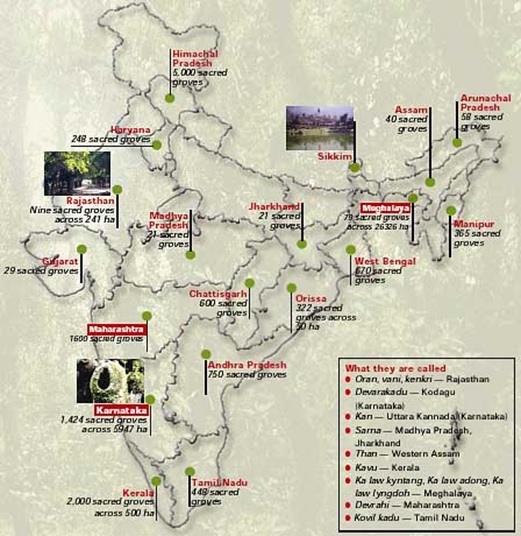

5th April 2022 (6 Topics)
Context
India’s sacred groves are being gradually altered due to ever-expanding human populations, pollution and removal of biomass; effective conservation is the need of the hour to maintain their functional values.
About
What are sacred groves?
- A sacred forest or grove comprises patches of natural vegetation – from a few trees to several acres – that are dedicated to local deities or tree spirits.
- Sacred groves are patches of natural vegetation preserved by ancient societies on religious and cultural grounds. These patches of vegetation are rich in biodiversity and act as habitats of many endangered and threatened plant species.
- These spaces are protected by local communities because of their religious beliefs and traditional rituals that run through several generations.
- A sacred grove usually consists of a dense cover of vegetation including climbers, herbs, shrubs and trees, with the presence of a village deity and is mostly situated near a perennial water source.
- Sacred groves are considered to be symbols of the primitive practice of nature worship and support nature conservation to a great extent.
- The degree of sanctity accorded to the sacred groves varies from one area to another. In some forests, even the dry foliage and fallen fruits are not touched.
- People believe that any kind of disturbance will offend the local deity, causing diseases, natural calamities or failure of crops.
- For example, the Garo and the Khasi tribes of north-eastern India prohibit any human interference in the sacred groves.
- In other places, deadwood or dried leaves may be picked up, but the live tree or its branches are never cut.
- For example, the Gonds of central India prohibit the cutting of a tree but allow fallen parts to be used.
- The introduction of Wild Life (Protection) Amendment Act, 2002, provides government protection to these lands.
Counting Numbers
- It is estimated that India may have about 100,000 such groves. The names of such groves vary depending upon the region and language of our country.
- They are called with different names in different states:
- Sarna in Bihar
- Dev Van in Himachal Pradesh
- Devarakadu in Karnataka
- Kavu in Kerala
- Dev in Madhya Pradesh
- Devarahati or Devarai in Maharashtra
- Lai Umang in Maharashtra
- Law Kyntang or Asong Khosi in Meghalaya
- Oran in Rajasthan
- Kovil Kadu or Sarpa Kavu in Tamil Nadu

Ecological Significance
- Conservation of Biodiversity – The sacred groves are important repositories of floral and faunal diversity that have been conserved by local communities in a sustainable manner. They are often the last refuge of endemic species in a geographic region.
- Recharge of aquifers– The groves is often associated with ponds, streams or springs, which support the water requirements of the local people. The vegetative cover helps in the recharging aquifers.
- Soil conservation- The vegetation cover of the sacred groves improves the soil stability of the area and prevents soil erosion.
Threats to the Sacred Forests
The threats vary from one region to the other and even from one forest to the other. But the common threats identified are:
- Disappearance of the traditional belief systems, which were fundamental to the concept of sacred forests. These systems and their rituals are now considered mere superstition.
- Sacred forests in many parts of our country have been destroyed due to rapid urbanization and developmental interventions such as roads, railways tracks, and dams including commercial foretry. Encroachment has led to the shrinkage of some of the largest forests in the country.
- Many forests are suffering due to ‘Sanskritisation’ or the transformation of the primitive forms of nature worship into formal temple worship.
- Invasion by exotic weeds such as Eupatorium odoratum, Lantana camara and Prosopis juliflora is a serious threat to some grove.
- Pressures due to increasing livestock and fuelwood collection.


